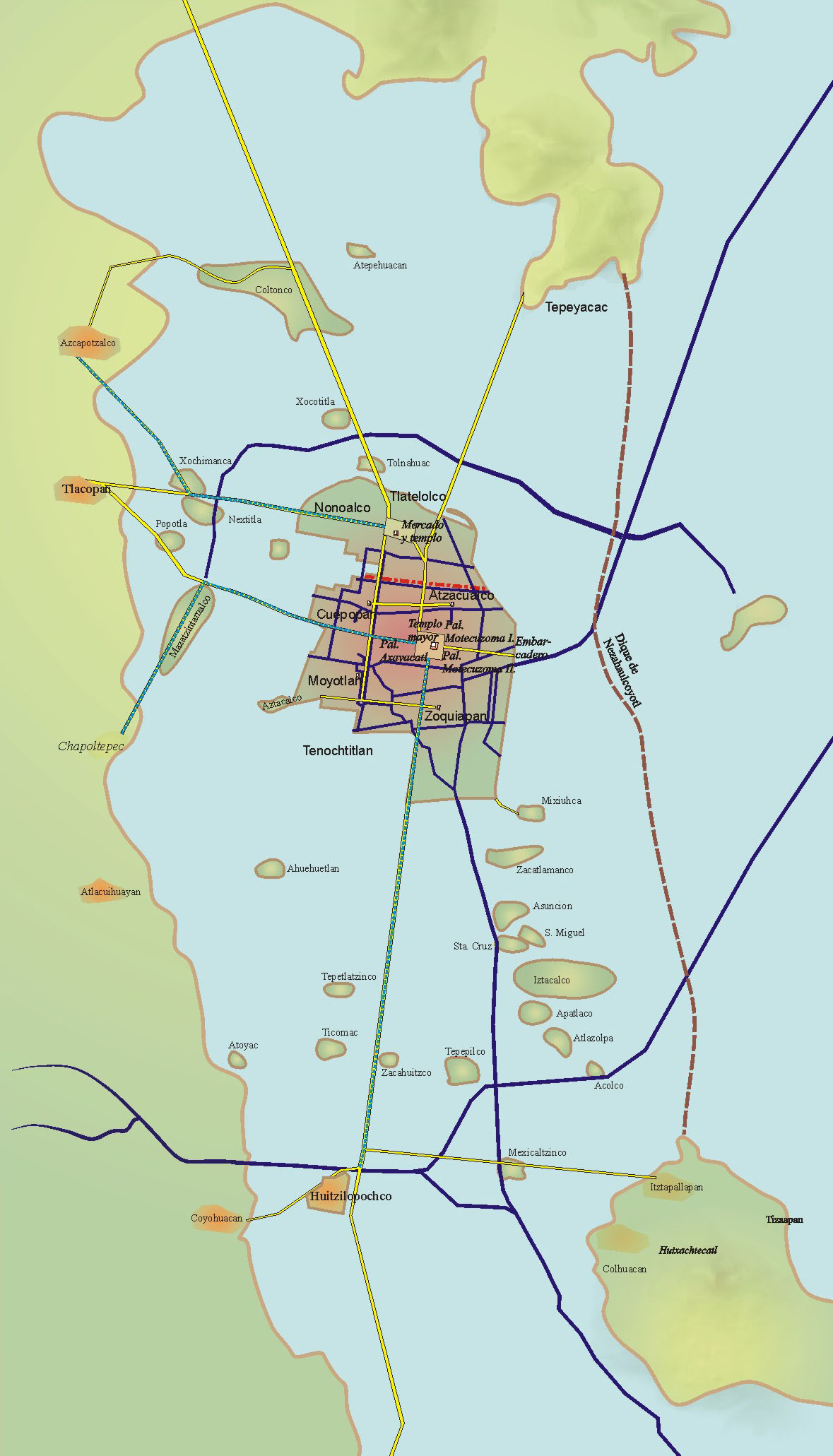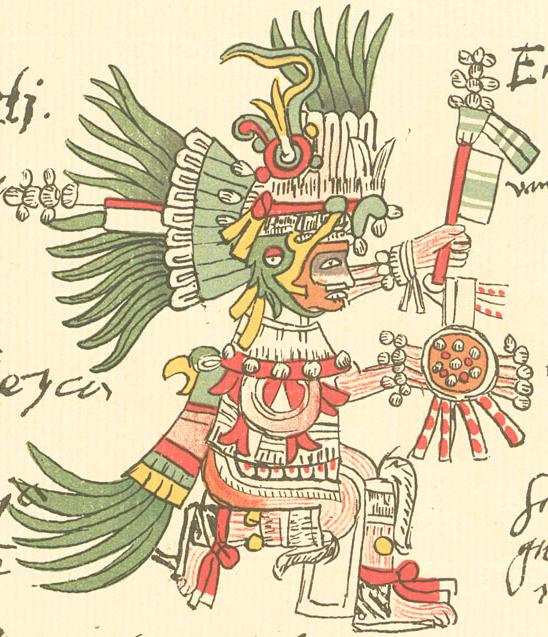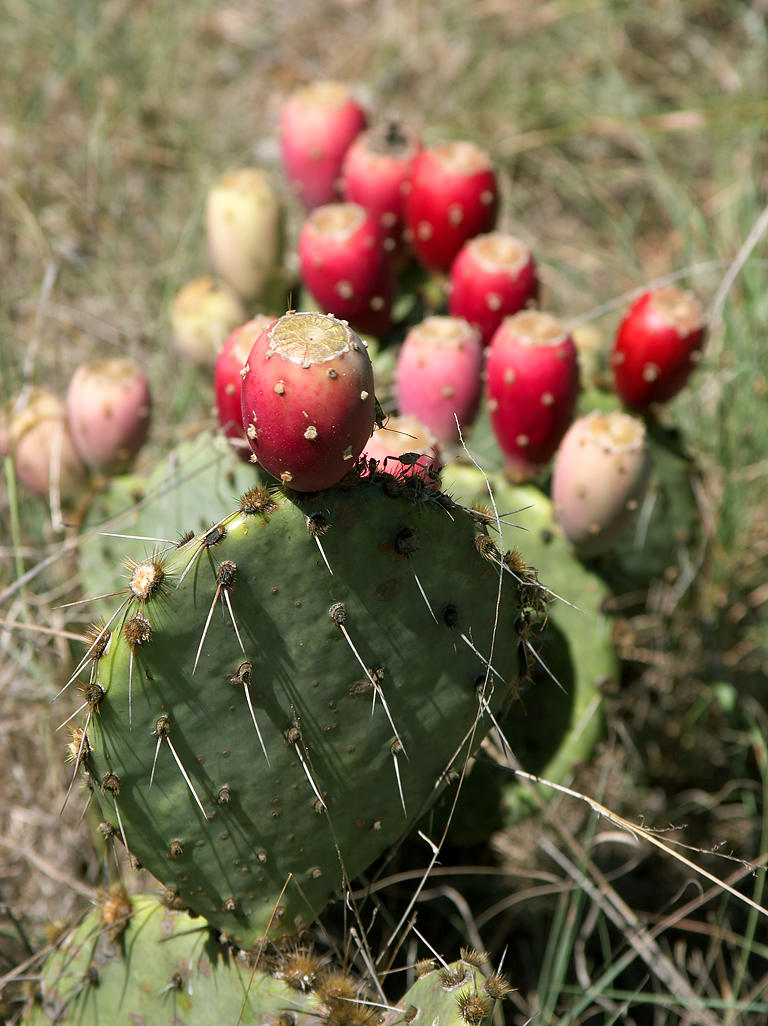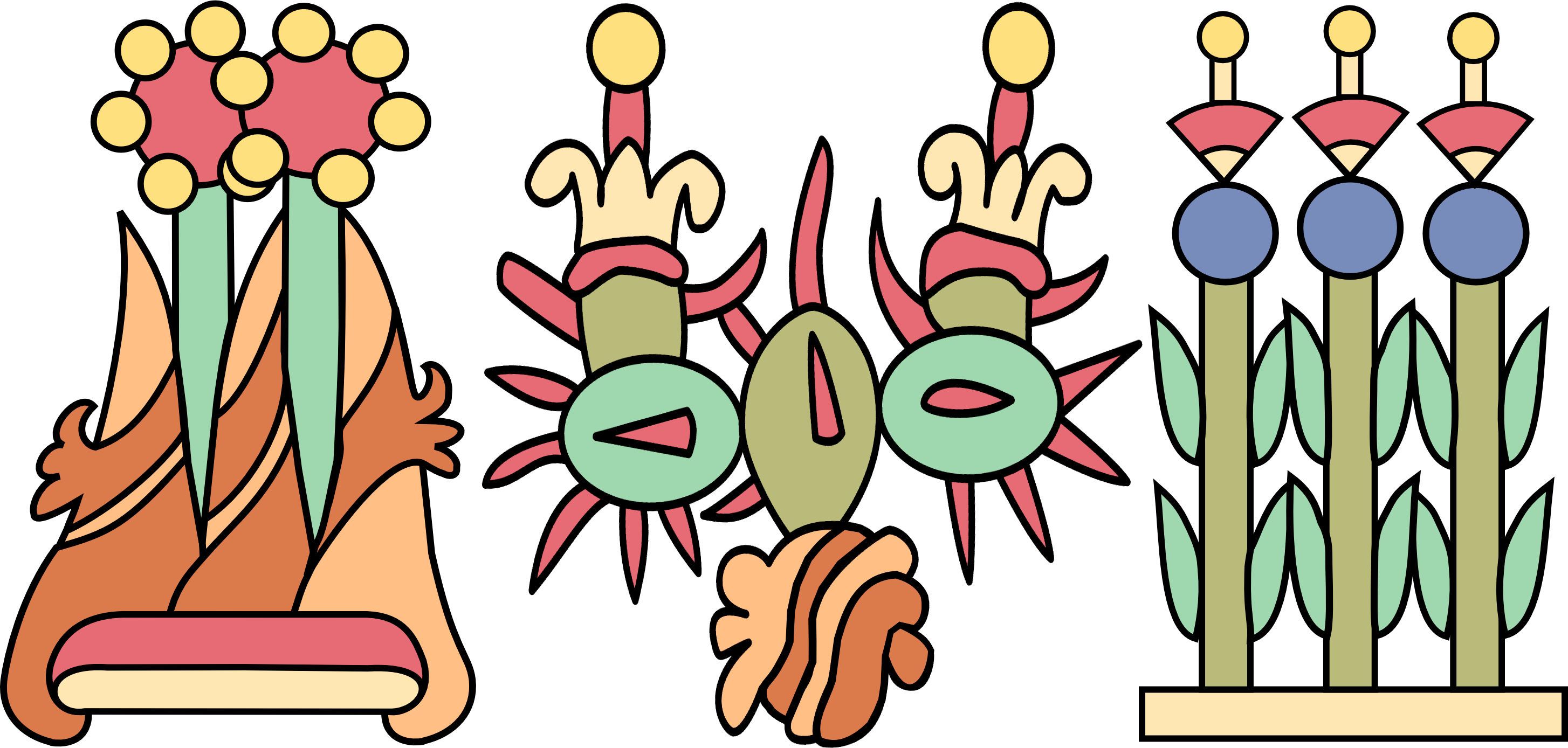|
Tenochitlan
, also known as Mexico-Tenochtitlan, was a large Mexican in what is now the historic center of Mexico City. The exact date of the founding of the city is unclear, but the date 13 March 1325 was chosen in 1925 to celebrate the 600th anniversary of the city. The city was built on an island in what was then Lake Texcoco in the Valley of Mexico. The city was the capital of the expanding Aztec Empire in the 15th century until it was captured by the Tlaxcaltec and the Spanish in 1521. At its peak, it was the largest city in the pre-Columbian Americas. It subsequently became a '' cabecera'' of the Viceroyalty of New Spain. Today, the ruins of are in the historic center of the Mexican capital. The World Heritage Site of contains what remains of the geography (water, boats, floating gardens) of the Mexica capital. was one of two Mexica (city-state A city-state is an independent sovereign city which serves as the center of political, economic, and cultural life over ... [...More Info...] [...Related Items...] OR: [Wikipedia] [Google] [Baidu] |
Mexica
The Mexica (Nahuatl: ; singular ) are a Nahuatl-speaking people of the Valley of Mexico who were the rulers of the Triple Alliance, more commonly referred to as the Aztec Empire. The Mexica established Tenochtitlan, a settlement on an island in Lake Texcoco, in 1325. A dissident group in Tenochtitlan separated and founded the settlement of Tlatelolco with its own dynastic lineage. In 1521, their empire was overthrown by an alliance of Spanish conquistadors and rival indigenous nations, most prominently the Tlaxcaltecs. The Mexica were subjugated under the Spanish Empire for 300 years, until the Mexican War of Independence overthrew Spanish dominion in 1821. Today, descendants of the Mexica and other Aztecs are among the Nahua people of Mexico. Since 1810, the broader term ''Aztec'' is often used to describe the Mexica. When a distinction is made, Mexica are one (dominant) group within the Aztecs. Names The ''Mexica'' are eponymous of the place name Mexico (''Mēxihco ... [...More Info...] [...Related Items...] OR: [Wikipedia] [Google] [Baidu] |
Mexico City
Mexico City is the capital city, capital and List of cities in Mexico, largest city of Mexico, as well as the List of North American cities by population, most populous city in North America. It is one of the most important cultural and financial centers in the world, and is classified as an Globalization and World Cities Research Network, Alpha world city according to the Globalization and World Cities Research Network (GaWC) 2024 ranking. Mexico City is located in the Valley of Mexico within the high Mexican central plateau, at an altitude of . The city has 16 Boroughs of Mexico City, boroughs or , which are in turn divided into List of neighborhoods in Mexico City, neighborhoods or . The 2020 population for the city proper was 9,209,944, with a land area of . According to the most recent definition agreed upon by the federal and state governments, the population of Greater Mexico City is 21,804,515, which makes it the list of largest cities#List, sixth-largest metropolitan ... [...More Info...] [...Related Items...] OR: [Wikipedia] [Google] [Baidu] |
Pre-Columbian
In the history of the Americas, the pre-Columbian era, also known as the pre-contact era, or as the pre-Cabraline era specifically in Brazil, spans from the initial peopling of the Americas in the Upper Paleolithic to the onset of European colonization of the Americas, European colonization, which began with Christopher Columbus's voyage in 1492. This era encompasses the history of Indigenous peoples of the Americas, Indigenous cultures prior to significant European influence, which in some cases did not occur until decades or even centuries after Columbus's arrival. During the pre-Columbian era, many civilizations developed permanent settlements, cities, agricultural practices, civic and monumental architecture, major Earthworks (archaeology), earthworks, and Complex society, complex societal hierarchies. Some of these civilizations had declined by the time of the establishment of the first permanent European colonies, around the late 16th to early 17th centuries, and are know ... [...More Info...] [...Related Items...] OR: [Wikipedia] [Google] [Baidu] |
Swamp
A swamp is a forested wetland.Keddy, P.A. 2010. Wetland Ecology: Principles and Conservation (2nd edition). Cambridge University Press, Cambridge, UK. 497 p. Swamps are considered to be transition zones because both land and water play a role in creating this environment. Swamps vary in size and are located all around the world. The water of a swamp may be fresh water, brackish water, or seawater. Freshwater swamps form along large rivers or lakes where they are critically dependent upon rainwater and seasonal flooding to maintain natural water level fluctuations.Hughes, F.M.R. (ed.). 2003. The Flooded Forest: Guidance for policy makers and river managers in Europe on the restoration of floodplain forests. FLOBAR2, Department of Geography, University of Cambridge, Cambridge, UK. 96 p. Saltwater swamps are found along tropical and subtropical coastlines. Some swamps have hammock (ecology), hammocks, or dry-land protrusions, covered by aquatic vegetation, or vegetation that tolerate ... [...More Info...] [...Related Items...] OR: [Wikipedia] [Google] [Baidu] |
Tenochtitlan
, also known as Mexico-Tenochtitlan, was a large Mexican in what is now the historic center of Mexico City. The exact date of the founding of the city is unclear, but the date 13 March 1325 was chosen in 1925 to celebrate the 600th anniversary of the city. The city was built on an island in what was then Lake Texcoco in the Valley of Mexico. The city was the capital of the expanding Aztec Empire in the 15th century until it was Fall of Tenochtitlan, captured by the Tlaxcaltec and the Spanish in 1521. At its peak, it was the largest city-state, city in the pre-Columbian Americas. It subsequently became a ''Municipalities of Mexico, cabecera'' of the Viceroyalty of New Spain. Today, the ruins of are in the historic center of the Mexican capital. The World Heritage Site of contains what remains of the geography (water, boats, Chinampa, floating gardens) of the Mexica capital. was one of two Mexica (city-states or Polity, polities) on the island, the other being . Etymol ... [...More Info...] [...Related Items...] OR: [Wikipedia] [Google] [Baidu] |
Tenoch
Tenoch (or Tenuch, ) was a ruler of the Mexicas (Aztecas) during the fourteenth century during the Aztec travels from Aztlán to Tenochtitlan. The Tenochtitlan people were originally referred to as Tenochca, then the Mexica. He was a respected chief who was elected to power by the council of elders and died sometime between 1350 and 1375, depending on the source. Tenoch was one of nine Mexica leaders who were told how Mexica could gain support from the forces of nature. After traveling southward for a span of 200 years, the Mexica found the sign. In honor of their leader, they named the small, reedy island in Lake Texcoco, Tenochtitlan. Tenochtitlan soon became the capital of the Aztec Empire. The Nahuatl symbols of his name are found in the Mexican flag The national flag, national flag of Mexico () is a vertical Tricolour (flag), tricolor of green, white, and red with Coat of arms of Mexico, the national coat of arms charge (heraldry), charged in the center of the white ... [...More Info...] [...Related Items...] OR: [Wikipedia] [Google] [Baidu] |
Frances Karttunen
Frances Esther Karttunen (born 1942), also known as Frances Ruley Karttunen, is an American academic linguist, historian and author. Education and career She received her BA in 1964 from Harvard and her PhD in 1970 from Indiana University Bloomington, with a dissertation entitled ''Problems in Finnish Phonology''. Most of her academic career was spent in association with the University of Texas at Austin, where she held researcher and lecturer positions for over 30 years, until her retirement in 2000, as senior university research scientist at the Linguistics Research Center. In her linguistics career Karttunen has specialised in the study of Mesoamerican languages such as Mayan but in particular Nahuatl, on which topic she has authored seven books and numerous academic papers. She has also written about endangered languages, linguistic diversity and language translation. Early in her career Karttunen also produced several studies of Finnish phonology and syntax, including h ... [...More Info...] [...Related Items...] OR: [Wikipedia] [Google] [Baidu] |
Opuntia
''Opuntia'', commonly called the prickly pear cactus, is a genus of flowering plants in the cactus family Cactaceae, many known for their flavorful fruit and showy flowers. Cacti are native to the Americas, and are well adapted to arid climates; however, they are still vulnerable to alterations in precipitation and temperature driven by climate change. The plant has been introduced to parts of Australia, southern Europe, the Middle East, and northern Africa. ''Prickly pear'' alone is more commonly used to refer exclusively to the fruit, but may also be used for the plant itself; in addition, other names given to the plant and its specific parts include ''tuna'' (fruit), ''sabra'', ''sabbar'', '' nopal'' (pads, plural ''nopales'') from the Nahuatl word , nostle (fruit) from the Nahuatl word , and paddle cactus. The genus is named for the Ancient Greek city of Opus. The fruit and leaves are edible. The most common culinary species is the "Barbary fig" ('' Opuntia ficus-indica ... [...More Info...] [...Related Items...] OR: [Wikipedia] [Google] [Baidu] |
Nahuatl
Nahuatl ( ; ), Aztec, or Mexicano is a language or, by some definitions, a group of languages of the Uto-Aztecan language family. Varieties of Nahuatl are spoken by about Nahuas, most of whom live mainly in Central Mexico and have smaller populations Nahuatl language in the United States, in the United States. Nahuatl has been spoken in central Mexico since at least the seventh century CE. It was the language of the Mexica, who dominated what is now central Mexico during the Late Postclassic period of Mesoamerican chronology, Mesoamerican history. During the centuries preceding the Spanish conquest of the Aztec Empire, the Aztecs had expanded to incorporate a large part of central Mexico. Their influence caused the variety of Nahuatl spoken by the residents of Tenochtitlan to become a prestige language in Mesoamerica. Following the Spanish conquest, Spanish colonists and missionaries introduced the Latin script, and Nahuatl became a literary language. Many chronicles, gram ... [...More Info...] [...Related Items...] OR: [Wikipedia] [Google] [Baidu] |
Tlatelolco (altepetl)
Tlatelolco ( , ) (also called Mexico Tlatelolco) was a pre-Columbian altepetl, or city-state, in the Valley of Mexico. Its inhabitants, known as the ''Tlatelolca'', were part of the Mexica, a Nahuatl-speaking people who arrived in what is now central Mexico in the 13th century. The Mexica settled on an island in Lake Texcoco and founded the ''altepetl'' of Tenochtitlan, Mexico-Tenochtitlan on the southern portion of the island. In 1337, a group of dissident Mexica broke away from the Tenochca leadership in Tenochtitlan and founded Mexico-Tlatelolco on the northern portion of the island. Tenochtitlan was closely tied with its sister city, which was largely dependent on the market of Tlatelolco, the most important site of commerce in the area. History In 1337, thirteen years after the foundation of Tenochtitlan, the Tlatelolca declared themselves independent from the Tenochca and inaugurated their first independent ''tlatoani'' (dynastic ruler). Under the king Quaquapitzahuac (1 ... [...More Info...] [...Related Items...] OR: [Wikipedia] [Google] [Baidu] |
Polity
A polity is a group of people with a collective identity, who are organized by some form of political Institutionalisation, institutionalized social relations, and have a capacity to mobilize resources. A polity can be any group of people organized for governance, such as the board of a corporation, the government of a country, or the government of a country subdivision. A polity may have various forms, such as a republic administered by an elected representative, the realm of a hereditary monarch, and others. The preeminent polities today are Westphalian sovereignty, Westphalian states and nation-states, commonly referred to as countries. Overview In geopolitics, a polity can manifest in different forms such as a State (polity), state, an empire, an international organization, a political organization or another identifiable, resource-manipulating organizational structure. A polity like a state does not need to be a Sovereignty, sovereign unit. The preeminent polities tod ... [...More Info...] [...Related Items...] OR: [Wikipedia] [Google] [Baidu] |
Chinampa
Chinampa ( ) is a technique used in Agriculture in Mesoamerica, Mesoamerican agriculture which relies on small, rectangle, rectangular areas of fertility (soil), fertile arable land to grow agriculture, crops on the shallow lake beds in the Valley of Mexico. The word chinampa has Nahuatl origins, chinampa meaning “in the fence of reeds”. They are built up on wetlands of a lake or freshwater swamp for agricultural purposes, and their proportions ensure optimal moisture retention. This method was also used and occupied most of Lake Xochimilco. The United Nations designated it a Globally Important Agricultural Heritage System in 2018. Although different technologies existed during the Post-classical history, Post-classic and Colonial periods in the basin, chinampas have raised many questions about agricultural production and political development. After the Aztec Empire, Aztec Triple Alliance formed, the conquest of southern basin city-states, such as Xochimilco, was one of th ... [...More Info...] [...Related Items...] OR: [Wikipedia] [Google] [Baidu] |








